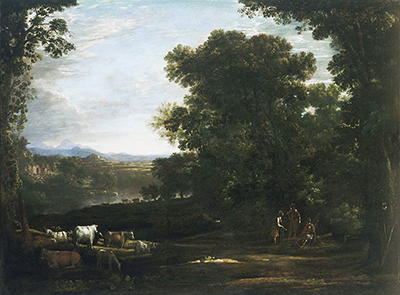Landscape with Cattle and Peasants was completed by Claude Lorrain in 1629, by which point he would have been in his mid to late twenties. By now, the artist was just starting to form a clear and consistent style that would remain constant through the rest of his career.
Claude would often use mythological or religious topics within his work but in the case of this painting the figures serve little more than an aesthetic purpose. Several workers are sat together on the right hand side of the foreground, whilst the cattle are across on the left. There is a flurry of trees and foliage around them which opens up around the centre of the composition, allowing us to see through towards the background. A deep drop leaves a chasm across the centre of the work, before the land rises again to reveal a patchwork of fields in the far distance. The bright blue sky which we find so often within this artist's career than dominates the top half of the canvas as we look towards the far distance. Claude was a true master of perspective within his landscapes which continued some of the styles found within Italian art leading up to that point. Claude himself was French but delivered most of his best work whilst in Italy.
The artist practiced his handling of human figures and those of animals throughout his career but was never considered a master within this field. He impressed most with his balance of light that would reflect across his calm lakes and rivers, as well as the rolling hills which were inspired by his time in the French and Italian countryside. He would reduce the figures in size perhaps in part to avoid any of these imperfections being noticed and he was entirely aware of his shortcomings. He loved to sketch whilst outdoors but normally focused on landscape compositions and that is where his true passion always lied. It was necessary to address figurative art in order to widen his pool of patrons, and this flexibility allowed him to enjoy financial security once his artistic reputation had been established.
This impressive piece was titled Landscape with Cattle and Peasants and today resides in the permanent collection of the Philadelphia Museum of Art in the US. The artist became involved in etching as well and some of the prints from these designs can also be found within this popular institution. It is relatively rare to see any of his original paintings within the US, with most found today in Italy, France and the UK. Many collectors fought over his work in the 19th century, increasing the valuations of his work and also raising the profile of his legacy, which by that stage was already considerable. We now remember him as a critical player in the rise of landscape painting, and someone who started the push towards what would become the Impressionist movement many centuries later, thanks to its influence on other European movements which came before that point.




